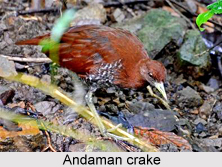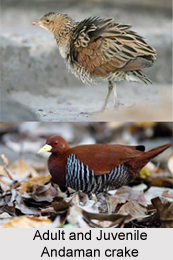 Andaman crake is an Indian bird in the family of Rallidae. Andaman crake bears a scientific name "Rallina canningi" and its existence was described in the natural journal published from India in 1863.
Andaman crake is an Indian bird in the family of Rallidae. Andaman crake bears a scientific name "Rallina canningi" and its existence was described in the natural journal published from India in 1863.
Description of Andaman Crake
Andaman crake was first described as the Andaman banded crake Euryzona canningi by Blyth in the year 1863 issue of the journal, Ibis. Later, Andaman crake was treated as Andamaneese banded crake Rallina canningi by Baker, an ornithologist in the year 1929. Subsequently, Ripley and Salim Ali retained Baker`s scientific name for the species, while reverting to Blyth`s common name- Andaman crake.
Structure of Andaman Crake
Andaman Crake is the largest species in the Rallina family, with a measurement about 34 cm in length. Andaman crake has a glossy chestnut plumage, extensive bold barring on under parts, unbarred undertail-coverts, relatively bright apple-green bill and relatively long and fluffy tail; legs and feet are olive-green. It also has pale barring on wings confined to outer primaries and greater and medium coverts.
Description of Young Andaman Crake
The juvenile Andaman crake are duller and less prominently barred. Other similar looking crakes include other Rallina and ruddy-breasted crake Porzana fusca. They are smaller and do not have green bill and legs. Immature birds are duller overall with the barred areas being dark grey-brown with a chestnut tinge, narrowly banded and streaked dirty white. Juvenile birds are paler than adult
.
Voice of Andaman Crake
The voice of Andaman crake is a deep croak. It utters a sharp click as an alarm call.
Concentration of Andaman Crake
The natural habitat of Andaman crake is marshland inside subtropical or tropical moist lowland forests, subtropical or tropical mangrove forests. It is threatened by habitat loss.
Residence of Andaman Crake
It is known from North Andaman Islands, Middle Andaman Islands and South Andaman Islands (Andaman and Nicobar Islands), the Andaman crake resides. It also inhabits on other islands such as Great Coco or middle Coco Islands. It was formerly classified as data deficient by the IUCN, due to the lack of reliable information on its status.
Breeding Season of Andaman Crake
Andaman crake breeds between June and August. Andaman crake nests at the bottom of large trees with buttresses or under tangled undergrowth in forests. In one study, the species preferred trees such as Terminalia, Tetrameles nudiflora or Pterocarpus, possibly near water bodies.
Eggs of Andaman Crake
The eggs of Andaman crake are similar to those of the banded crake but larger, whiter and glossier. Both sexes share in incubation. According to Baker, the eggs are about 40 by 30 mm.
Prey of Andaman Crake
Andaman crake feeds on small fish, molluscs, worms and insects like beetles, grasshoppers and caterpillars. The large grasshoppers are shaken about and battered before swallowing by Andaman crake.
Threats to Andaman Crake
In the 1980s, Andaman crake was considered to be quite common on the islands; over 80 birds were snared in a square mile. It is much rare now even though there are extensive forests in the islands. Introduced predators may also pose a risk to the birds` population.











